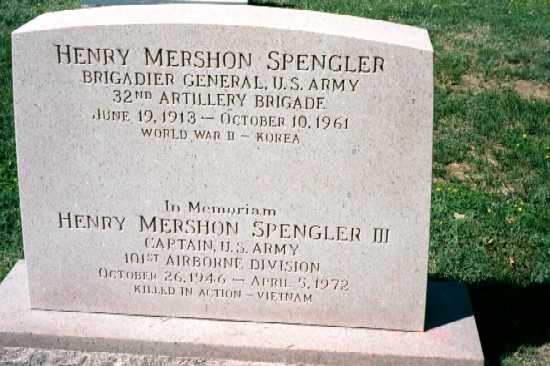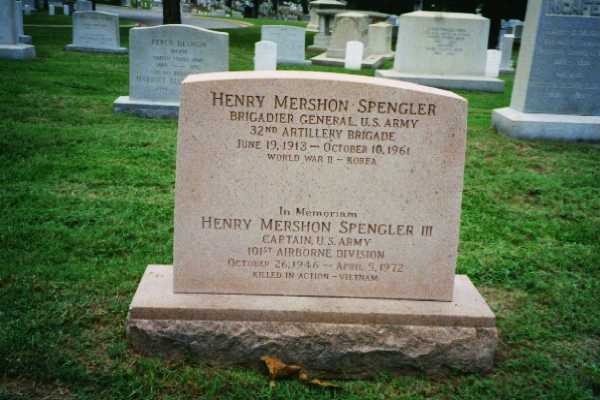

The son of a career Army officer, he was born on October 26, 1946 and graduated from West Point in June 1968.
He was killed-in-action on April 5, 1972 while serving with the 101st Airborne Division in the Republic of Vietnam. His body was not recovered and identified until 1989 and he was then buried in Section 3 of Arlington National Cemetery beside the gravesite of his father, Henry Mershon Spengler II, who had been killed in the crash of a military aircraft in Germany.
Another officer, Henry C. Spengler, who was killed in action in World War I, is buried nearby and research continues regarding him.
From a contemporary press report
August 24, 1989: Seventeen years after Army Captain Henry Mershon Spengler III of Alexandria was killed in action in South Vietnam, his remains are coming home. Of the 21 bodies of US servicemen expatriated by Vietnam on April 29, 1989 Captain Spengler’s are among only five positively identified by the Military Central Identification Laboratory in Honolulu. The others are undergoing analysis to determine identification. Captain Spengler, who was 26 years old when he was killed, will be buried Monday next to his father in Arlington National Cemetery.
“We’re not angry at the Army. It’s (Vietnam) a difficult country to deal with,” Betty Spengler, widow of Brigadier General Henry M. Spengler, said of the 17-year delay in receiving her son’s remains. Yesterday, the flag-draped coffins of Captain Spengler, Chief Warrant Officer Charles C. Windeler Jr. of Savannah, Ga., and Sergeant First Class Edward D. Reilly Jr. of Philadelphia arrived under military escort at Travis Air Force Base near San Francisco. The caskets were carried past an honor guard.
The short ceremony was made more poignant because Captain Spengler and Chief Warrant Officer Windeler died side by side on April 5, 1972. Captain Spengler was piloting a Cobra helicopter over An Loc, South Vietnam, when crews of nearby helicopters reported smoke coming from the engine exhaust. He and Chief Warrant Officer Windeler began to look for an open field for an emergency landing. Due to the altitude of the aircraft, they flew beyond the field. After they turned to make a proper approach, the helicopter made a 360-degree spin, recovered to a landing position, but then struck the ground hitting the right front skid. Flames spread from the engine compartment to the rear of the aircraft upon impact. Neither man could escape the aircraft. The airborne helicopters attempted to recover the bodies but were turned away by enemy anti-aircraft fire. Captain Spengler – a member of Troop F, 79th Artillery, 1st Calvary Division – would have finished his second and last year of duty in Vietnam four months after he was shot down.
“He was very enthusiastic about everything, but especially handball,” said Mrs. Spengler, whose son graduated from his father’s alma mater, West Point, in 1968. “There’s a special award given in his name for handball players at West Point. “He just loved life. He was a very warm, friendly person who liked to joke and just have a good time.”
Captain Spengler’s widow, Bette Meuleners, has remarried. Tomorrow, her husband, Lieutenant Colonel Michael S. Meuleners, a 1970 West Point graduate stationed at Ft Ord, California, will escort Captain Spengler’s casket from Travis Air Force Base to Washington, D. C.
Captain Spengler’s children, Henry IV and Melissa, and Mrs. Meuleners happened to be visiting Mrs. Spengler when the Pentagon telephoned last Friday with the bittersweet news that Captain Spengler’s remains had been found and identified.
“It does raise a lot of grief, but it does take away the waiting time to get the remains and have the final internment,” said Mrs. Spengler. Captain Spengler will take his place beside his father in Section 3, 2505-1, at Arlington National Cemetery at 10 a.m. Monday.
Although Mrs. Spengler initially decided to have only immediate family members at the funeral, she said those who have asked to be present include West Point friends of both her husband and her son, friends of the family and members of her church.
From a contemporary press report:
Captain Henry M. Spengler III’s mother originally thought her son would be buried at ANC with only the immediate family present. But Betty Spengler changed her mind after more than 100 friends, including a dozen or so officers who graduated from West Point with her son in 1968, contacted her about attending.
Captain Spengler’s remains, held by the Vietnamese government for 17 years after he was killed in action at age 26, were buried yesterday with full military honors.
The Remains of twenty-one American soldiers were repatriated by Vietnam on April 29. Captain Spengler’s, along with those of five others, have been positively identified by the Military Central Identification Laboratory in Honolulu.
In the interim years, Captain Spengler was remembered by his family in a special way. The words “In Memoriam” appear above the officer’s name on a black granite tombstone he shares with his father, Brigadier General Henry M. Spengler. They were etched there in 1972. Yesterday, a platoon of soldiers, Pershing’s Own Band and officers bearing the colors marched behind a horse-drawn caisson bearing Captain Spengler’s flag-draped coffin to a grassy knoll atop Arlington National Cemetery.
“With great pride, Henry followed in his father’s footsteps, first at West Point and then in the Army,” said James Locker in a graveside eulogy of his classmate at both Frances C. Hammond High School in Alexandria and West Point. Locker described his childhood friend as one who “loved to hear a good story or to tell one.” He reminded those present of Captain Spengler’s passion for handball. A special award is given to West Point’s best handball player in his name. After the eulogies, the Lord’s Prayer was recited by the mourners. Members of Captain Spengler’s family on hand included Mrs. Spengler; the Captain’s children, Melissa and Henry M. Spengler IV; and his widow, Bette Meuleners, whose husband, Lieutenant Colonel Michael S. Meuleners, escorted the coffin from California to Virginia.
The ceremony was punctuated by a 21-gun salute and the playing of taps. Tears flowed down the cheeks of Mrs. Spengler and her 2 teen-age grandchildren as each was presented with a folded American flag. The ceremony ended with the three Spenglers and Mrs. Meuleners each placing a long-stemmed American Beauty rose on Captain Spengler’s coffin.
Captain Spengler was a member of Troop F, 79th Artillery, 1st Cavalry Division. His awards include the Silver Star, Purple Heart, Air Medal (12th award), Army Commendation Medal, Ranger Tab, Parachute Badge and Army Aviation Badge. Captain Spengler would have finished his first year of duty in Vietnam four months after he was shot down on Apr 5, 1972.
Captain Henry Mershon Spengler III: “Hank” was Killed in action on 5 April 1972 near Loc Ninh in Binh Long Province. Originally assigned to A/4/77 at Phu Bai, Hank was reassigned to 4/79 ARA/1st Cavalry Division when his former unit was rotated to Fort Campbell in January 1972. The official records lists him as an “air loss”, “A3-type casualty” (died while missing as a result of hostile action). The following brief tribute of Hank was written by an anonymous friend & A/4/77 comrade:
“Hank Spengler was a roommate of mine and it was his professionalism and guidance that helped me to be a good Artillery Officer and Battery Commander. He wrote me several pages of guidance on what to do as a commander; since I was a new artillery officer at the time. Hank had been in country for less than six months when he requested to be moved south so he could get a “full tour” on his record (he could have taken a drop and gone home early). I heard that his aircraft was the first to be shot down by a shoulder fired SAM 7. When I first met Hank I liked him from the start. He told me how his family did not want him to go into aviation because his father (Army Brigadier General) was killed in a helicopter crash in Germany in 1961. He was determined to fly and was commissioned as an Engineer. Not too many of those in the pilot arena! He was a good pilot with a lot of common sense. I left A Battery before he did and was devastated when I read about him in the Army Times”
Other Personnel in Incident: Charles E. Windeler (remains returned)
SYNOPSIS:
On April 5, 1972, Captain Henry M. Spengler, pilot, and Warrant Officer Charles E. Windeler, aircraft commander, were flying as lead aircraft in an AH1G helicopter (tail #67-15594) against an enemy force in the vicinity of Loc Ninh in Vinh Long Province, South Vietnam.
As the helicopter was pulling off its second gun run, it was hit by enemy anti-aircraft fire. The helicopter began to descend with flames billowing from the exhaust area, and at about 300 feet above the ground, it appeared that the tail boom began to bend and wobble, causing the aircraft to spin to the left.
The gunship crashed, burst into flames, and exploded. Several members of the flight saw the helicopter during the descent and crash, but saw no one escape from the aircraft.
An aerial search was made by numerous aircraft, but no survivors were seen. No ground search was attempted due to hostile fire. An electronic search failed to locate any survivors.
Witnesses believed that Spengler and Windeler were killed in the crash of their helicopter. Because no bodies were found, they were listed with honor among the missing, prisoner, and unaccounted for from the Vietnam war.
For seventeen years, the Vietnamese denied knowledge of Spengler and Windeler, although the crash of the aircraft was in enemy-held territory, and it has always been thought that the Vietnamese knew what happened to the two men. Then, in late August, 1989, the U.S. announced that the Vietnamese had discovered and returned remains for both Spengler and Windeler.
Now, at least their families no longer wonder if they are among the hundreds said to be still alive in captivity. They know their men are dead. However, they may never know for sure how – or when – they died.

Michael Robert Patterson was born in Arlington and is the son of a former officer of the US Army. So it was no wonder that sooner or later his interests drew him to American history and especially to American military history. Many of his articles can be found on renowned portals like the New York Times, Washingtonpost or Wikipedia.
Reviewed by: Michael Howard

